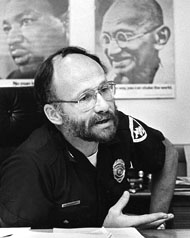 On September 16th, the 2nd Annual Conference on 21st Century Policing met again on the campus of the University of Wisconsin-Platteville (UW-P), drawing nearly 400 people, and taking seriously the notion that in a democratic society issues of policing are issues for everyone. With the theme “Building Trust and Legitimacy,” the conference unpacked various perspectives from police and other stakeholders about how use of force policies and practice have impacted community relations, particularly given recent high-profile incidents that have called into question police actions.
On September 16th, the 2nd Annual Conference on 21st Century Policing met again on the campus of the University of Wisconsin-Platteville (UW-P), drawing nearly 400 people, and taking seriously the notion that in a democratic society issues of policing are issues for everyone. With the theme “Building Trust and Legitimacy,” the conference unpacked various perspectives from police and other stakeholders about how use of force policies and practice have impacted community relations, particularly given recent high-profile incidents that have called into question police actions.
The keynote speaker, Chuck Wexler, Executive Director of the Police Executive Research Forum (PERF) in Washington, D.C. discussed his organization’s publication of a controversial, yet vitally important, document last year entitled “30 Guidelines on Use of Force.” Calling for major changes in how police train and use deadly force, the guidelines suggest raising the minimum standard offered in the Supreme Court decision in Graham v. Connor which privileges officers’ articulation of fear in justifying any action. They recommend that “the sanctity of human life” be at the core of what a police agency does, necessitating the adoption of de-escalation as a tactic and the crafting of less-deadly approaches to those who present as mentally ill.
Responding to Wexler was Dr. Mark Bowman of Methodist University in Fayetteville, North Carolina. Bowman called for putting real-time research into how decisions are made and stressing the importance of better and longer training for police. More than 40 years ago, President Johnson’s Commission on Law Enforcement found the number of training hours required to become a police officer was much less than required in many trades. Bowman made the point that in North Carolina and Wisconsin, for instance, the number of hours of training required to complete barber’s college was greater than the number of hours training required to complete a basic law enforcement training academy. The same disparity exists today. It is a good example of our failure as a nation to enact much needed change. His point is that if we are going to require a higher standard for police, we should be prepared as a nation to pay the cost. While most police training academies are heavily weighted toward firearms use, fewer hours are devoted to conflict management and how to de-escalate dangerous situations. That must change.
Noble Wray, a police reform specialist from the Department of Justice’s COPS Office, reported on efforts being made at the federal level to encourage and assist police departments and their leaders to implement the recommendations of President Obama’s Task Force on 21st Century Policing. He shared very impressive indicators that the nation’s police forces are slowly, but surely, moving forward. Thirty-eight of the Task Force’s recommendations, for example, were specifically designed be implemented by local police agencies immediately; the remainder are the responsibility of state and federal agencies. So far, 5,000 police agencies have been trained in these recommendations; that’s 1/3 of our nation’s police agencies. The result has been that 86,000 police officers have been trained in just the past 18 months.
The UW-P Conference, however, was not all about how police need to improve their use of deadly force, but about the importance of police and citizens coming to understand one another, being able to converse, and striving to meet one another’s needs. While the more careful use of deadly force would go a long way to improve a community’s trust of their police, much more is needed. And that’s where the voices of citizen leaders who attended the conference resonated. They had suggestions – some of them quite strong, but respectful.
One panel in particular represented the controversial and dynamic nature of police-community relations: “Building Trust and Legitimacy: Policing in the Community.” It included a Dane County (Wisc.) District Attorney Ismael Ozzane, a man of color, who recently made some tough decisions on police shootings. He offered a challenging suggestion to our nation’s problem of violence: train parents to create “no hitting” families; moving away from using corporal punishment as discipline.
Two panelists, Police Chief Jason King and Sergeant Tony Ruesga, Jr. from nearby Darlington, described how they recently experienced an influx of undocumented immigrants who came to work for a local cheese factory from Mexico. They now represent 15% of the community. Both talked about how they and the community positively responded to this potential crisis by opening up lines of communication and providing helpful translation and other social services well before any emergencies related to that community emerged. It could be a model for how historically White communities reach out to those who are different.
Amelia Royko Maurer gave an account of co-founding a community response team after two police shootings occurred in her neighborhood, one of which was next door to where she lived and took the life of a friend, Pauli Heenan; the second, Tony Robinson, a Black teenager was killed only a few blocks away. Another community voice came from Brandi Grayson, a Black mother carrying a young infant, who is one of the founders of a group called “Young, Gifted and Black” (YGB). YGB’s response to police shootings has been to call for total community control of police, because, she said, “Our babies are being killed.”
It was clear that tension still exists between those who work in the system (police and prosecutors) and those who are outside of it. Those outside the system, who receive police services, are often persons of color or people otherwise marginalized. Yet one of the goals of the conference was to provide a place where police and community leaders can listen and dialogue with one another without anger. To a great extent that was realized – even though many times the pain of the past was still sharply present in those who are still outside the system and were working to change it.
Another panel dealt with a very clear and present problem: how police (and our communities) respond to people who present to first-responders as mentally ill. The panel consisted of a Madison Police Captain Kristen Roman, who is responsible for the training and response to that population in her city, Lindsay Wallace, the director the Dane County branch of the National Association for the Mentally Ill (NAMI), a Sheriff Dave Mahoney, concerned about the “inhumanity” of using our jails to house our mentally ill, and a State Representative Chris Taylor, who successfully passed a bill for police reform in the Wisconsin state legislature. It created a law to prohibit police from investigating themselves when deadly force has been used.
We also heard from Michael Bell, Sr. whose son was shot and killed by Kenosha, Wisc. police in questionable circumstances. His city’s police department investigated the shooting and quickly absolved themselves. This drove Mr. Bell to successfully sue the city of Kenosha. He went on to engage in a multiple-year effort to introduce the new state law mentioned above. He is currently championing for a system that would nationally review all incidents of police use of deadly force along the lines of our federal National Transportation Safety Board (NTSB) which is focused on learning from mistakes rather than assigning blame. He also cited the recent discussion from the National Institute of Justice regarding adopting the improvement strategy of a “Sentinel Event,” which is used in the field of medicine, to policing .
Three interesting breakout sessions were held during the program: Lt. Dan Marcou, a police trainer explained use of force from his perspective, and “Dub” Lawrence, a retired sheriff explained how the SWAT team he founded ultimately ended up killing his son-in-law. Then two retired police leaders, me and John Mutz presented how W. Edwards Deming’s “systems thinking,” based on developing an internal appreciation of who an institution externally serves, can provide a method for police departments to successfully implement change. The last session was led by Alex Salazar, a former police officer involved in the corrupt LAPD Rampart Division in the 1990s. He shared why good cops need to do something about bad cops.
All in all, as one of the organizers of this annual conference along with the my colleagues in the Department of Criminal Justice at UW-P, I sense we are starting to develop a sincere dialogue in our area about police use of force and what police and citizens mean when they talk about community policing. To many of us in the police field, community policing means listening to, and working collaboratively with citizens on problems they identify, not just those which the police think are important.
“Most participants I talked to on all sides seemed to agree that the public is asking for Graham v. Connor to be as Wexler said: the floor not the ceiling,” explained Dr. Staci Strobl, Chair of the Criminal Justice Department at UW-P who solicited feedback from the conference. “In our region that is starting to become common ground to a certain extent, but how high the ceiling is will be a real negotiation. Police are very reluctant to cede the primacy of their perspective in judging appropriate use of force.”
But to many citizens today, especially those of color and who have received the brunt of policing throughout the years, communities must have more control, and some have called for local citizens to directly hire and fire police and to set policies and procedures. These are difficult words for those who are or have been police officers.
On the other hand, the idea is akin to that of Sir Robert Peel, founder of modern policing in the Anglo-American world. Peel and his associates in the 19th century put forth that the primary mission of the police is to prevent crime and disorder rather than responding to it by using force. They saw that the ability to do this was dependent upon the public’s approval of what police did and the ability of police to secure and maintain the public’s respect.
They also noted that citizen cooperation proportionately diminishes if routine physical force and compulsion is used to achieve their objectives. For Peel and his colleagues, force should only be used when “persuasion, advice and warning” were insufficient. But their most radical principle of all was the reminder that the police are the public and the public are the police; a true description and one police and communities should heed as they sort through a national crisis in the administration of justice.
This is the type of gathering that needs occur in each and every American city. We need to talk to one another and deeply listen. These are not easy things to talk about: force, fairness, respect, and trust. But if we don’t do this, we will continue to see too many lives extinguished and far too many personal indignities.


What about dealing with white collar corporate crime and crimes committed by wealthy people?
LikeLike